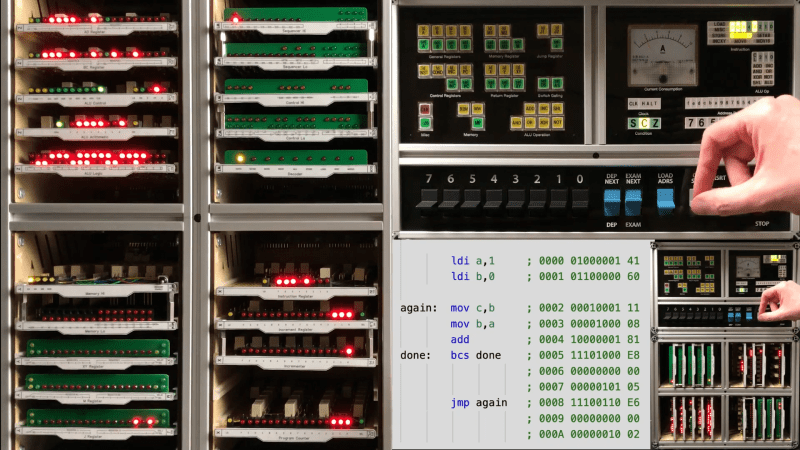You may not have noticed, but we here at Hackaday really love our clicky stuff. Clicky mechanical keyboards, unnecessarily noisy flip-dot displays, and pretty much anything made with a lot of relays — they all grab our attention, in more ways than one. So it’s with no small surprise that we appear to have entirely missed perhaps the clickiest build of all: a fully operational 8-bit computer using nothing but relays.
What’s even more amazing about our failure to find and feature [Paul Law]’s excellent work is that he has been at it for the better part of a decade now. The first post on his very detailed and very well-crafted blog describing the build dates from 2013, when he was just testing LEDs in the arithmetic-logic unit (ALU). Since then, [Paul] has made incredible progress, building module after module, each containing a small portion of the computer’s functionality. The modules plug into card cages with backplanes to connect them, and the whole thing lives in an enclosure made from aluminum extrusion and glossy black panels for a truly sleek look. The computer is incredibly compact for something that uses 400+ DPDT relays to do its thinking.
In addition to the blog, [Paul] has a criminally undersubscribed YouTube channel with a quite recent series going over the computer in depth. We included the overall tour below, but you should really check out the rest of the videos to appreciate how much work went into this build. We’ve seen relay computers ranging in size from single-board to just plain ludicrous, but this one really takes the prize for fit and finish as well as functionality.















Looks as good as a commercial product, yes, could be produced commercially, hmm, I’ll go with …
“I think there is a world market for maybe five computers.”
Thomas Watson, president of IBM, sometime in the 40s when this tech was current.
I mean it’s cool and all, but for the thousands of bucks it would likely have to sell for, I don’t think there would be many takers.
I think you are missing the point here.
Obviously the intention is not to sell it. There is no way a relay computer can be viable in 2021, other than as a conversation piece.
The comment about this looking like it could be a commercial product speaks to the build quality. The builder has done such a great job with this that one might think it’s an actual commercial product, albeit extracted from a time capsule from the 50’s.
How hard would it be to rig it up to let people connect to it over the internet, and run things on it?
E.g. something that receives tweets with programs in them, queues them up, automatically pulls the next job off the queue, loads it up and runs it, and fires off results, probably again via tweet. AND of course, some way to watch and listen to your program click through.
You know .. so I don’t have to source 1000 relays and get carpal tunnel from wiring them all up on me own?
I like this idea, it gives access to such a project to many people who otherwise would never experience it. Maybe have an emulator test the code in the backend first to prevent unknown code from causing problems before running on hardware.
I bet plenty of folks would be happy to send him $1 or buy him a cup of coffee to see/hear their little program to run on his machine. Might help him recoup part of the cost of all those relays!
Consider checking out http://homebrewcpu.com, it’s a similar sort of idea but with ttl, and running minix on the web. You can telnet in on a guest account.
The hardware interface to connect it up by TCP/IP would be far more complex than the computer, or build it an RS232-C link and plug that into a common RS232-C to ethernet dongle, then to a PC or something else that can itself connect to the internet.
I hadn’t even thought of running any kind of network stack directly on the relays, though that’s an entertaining idea.
Nah, I’d make some modern device listen for the input (e.g., scrape it from tweets), and feed it to the relay machine via something like 1200,n,8,1 serial.
Or maybe the relay machine would be happier being interfaced with parallel discretes, so you know, stick a gpio card on a Pi or something.
Give me a minute, I gotta pick my jaw up off the floor.
My thoughts exactly. Labor of love there…. Awesome…. And still a work in progress after all those years.
yes, because if it is finished, then… it’s over :-/
As long as there are enhancements to be made, the project is alive :-)
Dan : the project was listed for a long time on the dedicated Hackaday.io page ;-)
https://hackaday.io/project/11798/
But the new domain name was not updated, I admit.
A thing isn’t beautiful because it is practical or turns a profit
This is a work of art
I wonder why did he use to make those nice colorful diagramms, I mean the ones voltage vs time :)
Also interrested in an answer to that question :)
I think it’s diagrams.net
After putting my eyes back into place… the quality of execution is simply incredible! If this was a commercial product, I would surely try to get one.
Wonder how much did it cost to build it. Does anyone know?
I am in awe! What he did is amazing and it combines with the book iam reading: Turing’s cathedral
what am i missing? this is how i learned computer back in the early 80’S. this is how old pre digital phone switches worked, then we advanded to and/or switches and transistors, then chips.
I would like to know what those indicator rectangle light things are called. I would love some of those. same as the switches.